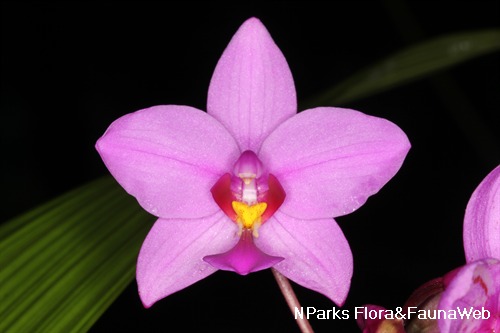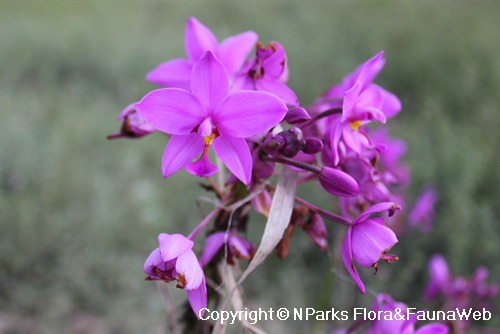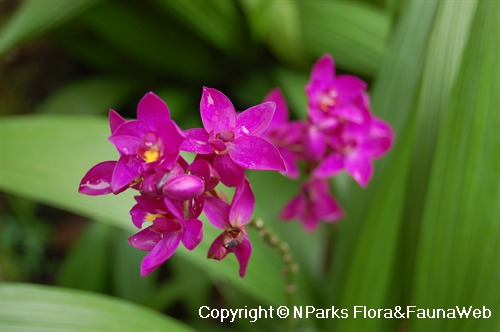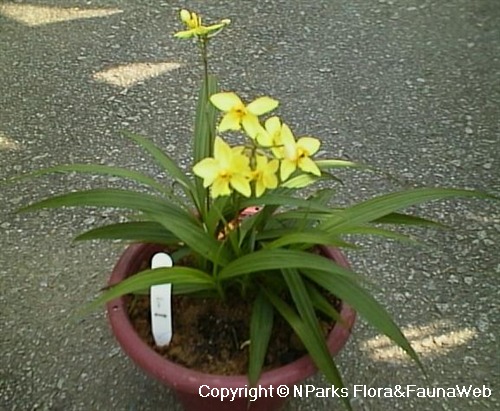
Back
Spathoglottis plicata Blume
| Family Name: | Orchidaceae |
| Synonyms: | Calanthe poilanei Gagnep., Phaius rumphii, Spathoglottis angustifolia, Spathoglottis daenikeri, Spathoglottis lilacina |
| Common Name: | Spathoglottis Orchid, Common Spathoglottis, Philippine Ground Orchid, Lumbah Tikus, Pleated Leaf Spathoglottis, Malayan Ground Orchid, 紫花苞舌兰 |
Name
Classifications and Characteristics
| Plant Division | Angiosperms (Flowering Seed Plants) (Monocotyledon) |
|---|---|
| Plant Growth Form | Shrub |
| Lifespan (in Singapore) | Perennial |
| Mode of Nutrition | Autotrophic |
| Maximum Height | 80 cm |
Biogeography
| Native Distribution | From Southern India, Southern China, Southern Japan, Indo-China, Myanmar, Thailand, Peninsular Malaysia, Singapore, Sumatra, Java, Borneo, Philippines, throughout Indonesia to Australia and the Pacific Islands. |
|---|---|
| Native Habitat | Terrestrial (Grassland / Savannah/ Scrubland, Disturbed Area / Open Ground) |
| Preferred Climate Zone | Tropical, Sub-Tropical / Monsoonal |
| Local Conservation Status | Native to Singapore (Least Concern (LC)) |
Description and Ethnobotany
| Growth Form | Medium to large terrestrial orchid commonly found in Singapore. |
|---|---|
| Foliage | Long, straplike leaves are light green and pleated. |
| Flowers | Pinkish purple, odourless flowers occur in groups of 5 - 30 and open a few at a time (4 cm wide). Flowers are composed of 1 dorsal sepal, 2 petals, 2 lateral sepals and a lip which are all pinkish purple. The terminal inflorescence is borne on a long stalk reaching up to 1.5 - 2 m in length. This species is free flowering. |
| Fruit | Seed pod is light green and cylindrical. |
| Habitat | Occurs on rocky, grassy slopes or dry lowland forests at altitudes of 0 - 700 m. |
| Associated Flora | The flowers are insect-pollinated. |
| Associated Fauna | It is often associated and likely has a mutually beneficial relationship with ants. |
| Cultivation | It can be propagated by seed or division of the pseudobulbs. |
| Etymology | Latin Spathoglottis, sheathed tongue, referring to the spathulate shaped lip. Latin pilicata, folded or plicate, referring to the plicate leaves (with distinctive longitudinal folds). |
| Ethnobotanical Uses | Medicinal: In Malaysia (Moluccas), leaves are applied to painful joints as a poultice. Others: It is commonly cultivated as an ornamental plant. |
Landscaping Features
| Landscaping | It can be planted in parks and gardens, at open and sunny locations for its attractive purple flowers and bushy form. |
|---|---|
| Desirable Plant Features | Ornamental Flowers |
| Landscape Uses | General, Parks & Gardens, Small Gardens, Flowerbed / Border |
Fauna, Pollination and Dispersal
| Pollination Method(s) | Biotic (Fauna) |
|---|---|
| Seed or Spore Dispersal | Abiotic |
Plant Care and Propagation
| Light Preference | Full Sun |
|---|---|
| Water Preference | Moderate Water |
| Plant Growth Rate | Moderate |
| Rootzone Tolerance | Moist Soils, Well-Drained Soils, Easy to Grow |
| Maintenance Requirements | Moderate |
| Propagation Method | Seed, Division, Tissue Culture |
Foliar
| Foliage Retention | Evergreen |
|---|---|
| Mature Foliage Colour(s) | Green |
| Foliar Type | Simple / Unifoliate |
| Foliar Arrangement Along Stem | Rosulate / Rosette |
| Foliar Attachment to Stem | Petiolate |
| Foliar Shape(s) | Non-Palm Foliage (Lanceolate, Linear) |
| Foliar Venation | Parallel |
| Foliar Margin | Entire |
| Foliar Apex - Tip | Acute |
| Foliar Base | Cuneate |
| Leaf Area Index (LAI) for Green Plot Ratio | 3.5 (Shrub & Groundcover - Monocot) |
Floral (Angiosperm)
| Flower & Plant Sexuality | Bisexual Flowers |
| Flower Colour(s) | Purple |
|---|---|
| Flower Grouping | Cluster / Inflorescence |
| Flower Location | Terminal |
| Flower Symmetry | Bilateral |
Fruit, Seed and Spore
| Mature Fruit Colour(s) | Brown |
|---|---|
| Fruit Classification | Simple Fruit |
| Fruit Type | Dehiscent Dry Fruit , Capsule |
Image Repository
Others
| Master ID | 1175 |
|---|---|
| Species ID | 2468 |
| Flora Disclaimer | The information in this website has been compiled from reliable sources, such as reference works on medicinal plants. It is not a substitute for medical advice or treatment and NParks does not purport to provide any medical advice. Readers should always consult his/her physician before using or consuming a plant for medicinal purposes. |









